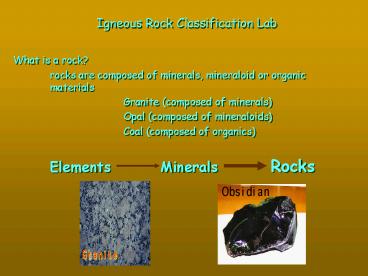Igneous Rock Classification Lab PowerPoint PPT Presentation
1 / 11
Title: Igneous Rock Classification Lab
1
Igneous Rock Classification Lab
- What is a rock?
- rocks are composed of minerals, mineraloid or
organic materials - Granite (composed of minerals)
- Opal (composed of mineraloids)
- Coal (composed of organics)
- Elements Minerals Rocks
2
Igneous Rock Classification Lab
- Lets form an igneous rock
- Two major types of igneous rocks
- Intrusive magma solidifies below the Earths
surface - magma cools very slow
- crystals form interlocking mosaic textures
- very coarse-grained visible minerals
- referred to as Plutonic rocks
- Extrusive magma solidifies above the Earths
surface - magma cools very fast
- minerals can not be seen with un-aided eye
- very fine-grained texture (no visible minerals
- referred to as Volcanic rocks
Extrusive rocks
Intrusive rocks
3
Igneous Rock Classification Lab
- Igneous Rock Classification
- Identification of Igneous rocks is based on two
main characteristics - Texture the appearance of the rock due to the
rate of magma cooling - Composition the type of minerals found in the
rock (mineral
composition)
Textures of igneous rocks Intrusive rocks
(Textural terms) phaneritic texture crystals
are visible and form a mosaic of
interlocking mineral aggregates (less
than 1 cm)
Interlocking crystal grains phaneritic texture
4
Igneous Rock Classification Lab
- pegmatitic texture crystals are very large
(gt1cm)
Large orthoclase and plagioclase minerals
Extrusive Igneous Rocks (textural terms)
aphanitic texture crystals are too small to see
See, you really can not see any mineral crystals
5
Igneous Rock Classification Lab
- porphyritic texture crystals can be separated
into two distinct visible sizes. There can be
small grains or
large grains, but crystals appear in
2-distinct sizes
Phenocrysts
Groundmass (matrix)
6
Igneous Rock Classification Lab
- Vesicular texture- sponge like appearance,
texture contains numerous cavities or holes
Vesicles gas bubbles cavities
Pyroclastic texture textures created by rapidly
cooling lava that is
hurled through the air picking up
fragments (tuffaceous texture)
rock fragments pieces of rock incorporated
into the rock (tuffaceous)
7
Igneous Rock Textures
Intrusive Extrusive
Rock cooled slowly
Rock cooled rapidly
Texture types phanartitic pegmatitic
Texture types aphanitic porphyritic vesicular
pyroclastic tuffaceous
8
Igneous Rock Classification Lab
- Igneous Rock Composition
- mineral composition mineral assemblages
chemistry - The mineral is either ferromagnesian (dark
colored) or felsic (light colored - ferromagnesian (mafic)
- minerals rich in Fe, Mg creates a dark
colored rocks
Pyroxene (Augite)
Amphibole (hornblende)
Mica - Biotite
9
Igneous Rock Classification Lab
- Igneous Rock Composition
- Mineral composition Mineral assemblages
Chemistry - The mineral is either ferromagnesian (dark
colored) or felsic (light colored) - Felsic mineral composition is light colored
minerals
Ca-plagioclase
K-feldspar (orthoclase)
Mica- muscovite
Quartz
10
Igneous Rock Classification Lab
- Lets use Texture and Composition to
identify igneous rocks - Steps for identifying igneous rocks
- Identify the texture (phaeritic/aphanitic)
- If the rock is phaneritic, estimate the of
felsic and mafic minerals - High mafic dark colored rock
- High felsic light colored rock
- 50 felsic, 50 mafic intermediate color
- Use your igneous rock schematic and cross
reference the texture and composition (light,
intermediate, dark) and name the rock. Add
modifying terms (porphyritic, vesicular ect.)
11
Igneous Rock Classification
Felsic
Mafic
80
Origin
Texture
40
20
Rock Descriptions
Very coarse crystal grains, usually all grains
are approximately the same size w/ respect to
each other. Grainsgt one inch
Very Coarse
Mafic Pegmatite
Granite Pegmatite
Intrusive
A mosaic of coarse-grains that are easily visible
to the unaided eye grains greater than 1 mm
Grano- diorite
Phane- ritic
Peridotite
Gabbro
Diorite
Granite
Fine to very fine grains, usually to small to be
distinguished with the unaided eye or even with a
hand lens
Aphan- itic
X
Rhyolite
Dacite
Andesite
Basalt
Glassy
Glassy non-crystalline, non-granular Color
varies between black and brown
Obsidian
Extrusive
Por- ous
Highly vesicular, finely crystalline to
glassy Pumice (light), Scoria (dark)
Pumice
Scoria
Composed of fragments of all sizes Produced in
volcanic environments, Ash Partially re-fused or
cemented
Basaltic Tuff
Rhyolitic Tuff
Frag- mental

